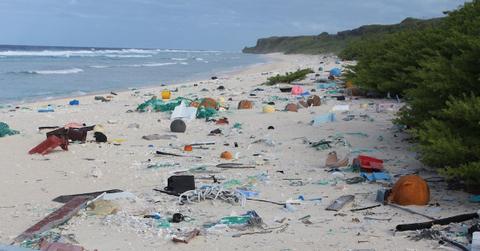This Island Has No People But 38 Millions Of Pounds Of Trash On Its Beaches
Henderson Island, a UNESCO World Heritage site, highlights how polluted the Pacific Ocean has become. Millions of pounds of plastic waste has been found on the uninhabited land. Objects include plastic toys, cosmetic items, and more.
Updated Nov. 19 2020, 9:38 p.m. ET

The Great Pacific garbage patch is an area in the Pacific Ocean where pollution has gathered from ocean currents. Its size is estimated to be up to roughly double that of the continental United States. All that garbage and toxic chemicals can eventually find its way onto beaches and it can affect much of the wildlife in the area. One uninhabited island in the South Pacific has seen an unprecedented amount of trash wash up on its shores.
Researchers from the University of Tasmania and the United Kingdom’s Royal Society for the Protection of the Birds found Henderson Island loaded with debris from all over the world. Nearly 18 metric tons, or 40,000 pounds, of this garbage was planted on the six-mile long, three-mile wide island, and there were 38 million pieces of plastic found. That tallies up to about 99.8 percent of the pollution according to a report from The Guardian.
Plastic pollution has been the biggest culprit in the Pacific Ocean. Considering US citizens alone throw away 185 pounds of plastic per year and 80 percent of plastic from the land gets into the ocean, it’s no surprise to see a buildup of pollution this massive. These pieces outnumber the animals by a six-to-one ratio. Animals and fish in the area also suffer from eating these objects. In turn, we could be eating these plastics ourselves.
It isn’t just the United States that’s pegged with this problem, however. Jennifer Lavers, who works with the Institute for Marine and Antarctic Studies at the University of Tasmania, told The Guardian that everyone’s trash is involved.
“Across the board, no country got a free pass on this – we found bottles from Germany, containers from Canada, I think it was a fishing crate from New Zealand. What that says is we all have a responsibility in this, and we have to sit up and pay attention to that.”
Lavers has studied this island for a 3.5-month period in 2015. 13,000 different objects make their way to the island every single day. She described how random the trash in an Associated Press report. Most of the objects were of the plastic variety, ranging from “red motels from the Monopoly board game” to cosmetic tools like toothbrushes.
Henderson Island is a UNESCO World Heritage site, joining the list of places like the Taj Mahal, Stonehenge, and the Great Barrier Reef. It’s also one of the most filthiest remote islands untouched by humans. It acts more as a net for all the pollution that’s in the water. All that trash is harmful to the wildlife; Lavers couldn’t believe the amount of crabs that were using the products as homes. Unfortunately, toxic chemicals from the waste could be dangerous for their health and they didn’t need to live inside of them.
Lavers’ study is another prime example of how terrible plastic pollution has become in the oceans. With production only rising in our future, her message bears repeating -- it’s time to make a difference when it comes to recycling and limiting use of the product.